
Invertebrate paleontology is sometimes described as invertebrate paleozoology or invertebrate paleobiology. Whether it is considered to be a subfield of paleontology, paleozoology, or paleobiology, this discipline is the scientific study of prehistoric invertebrates by analyzing invertebrate fossils in the geologic record.
Tempo and Mode in Evolution (1944) was George Gaylord Simpson's seminal contribution to the evolutionary synthesis, which integrated the facts of paleontology with those of genetics and natural selection.

The Journal of Asian Studies, the flagship journal of the Association for Asian Studies, is the most authoritative and prestigious peer-reviewed academic journal in the field of Asian studies. With an acceptance rate of approximately 6%, it upholds rigorous standards in the evaluation and publication of scholarly research. Each issue of the Journal of Asian Studies circulates over 8,200 copies, reaching a readership across the academic community and beyond.

Paleobiology is an interdisciplinary field that combines the methods and findings found in both the earth sciences and the life sciences. Paleobiology is not to be confused with geobiology, which focuses more on the interactions between the biosphere and the physical Earth.

Cramauchenia is an extinct genus of litoptern South American ungulate. Cramauchenia was named by Florentino Ameghino. The name has no literal translation. Instead, it is an anagram of the name of a related genus Macrauchenia. This genus was initially discovered in the Sarmiento Formation in the Chubut Province, in Argentina, and later it was found in the Chichinales Formation in the Río Negro Province and the Cerro Bandera Formation in Neuquén, also in Argentina, in sediments assigned to the SALMA Colhuehuapian, as well as the Agua de la Piedra Formation in Mendoza, in sediments dated to the Deseadan. In 1981 Soria made C. insolita a junior synonym of C. normalis. A specimen of C. normalis was described in 2010 from Cabeza Blanca in the Sarmiento Formation, in sediments assigned to the Deseadan SALMA.

Daonella is a genus of oyster-like saltwater clams, marine bivalve mollusks which lived in the middle to late Triassic period. They are related to the genera Aparimella and Halobia. Since they were ubiquitous in the Arctic, Tethys and Panthalassa seas, they are frequently used as index fossils in dating rocks to the Triassic period. However, the systematic classification of the Daonella is still an area of ongoing research.
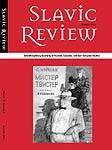
The Slavic Review is a major peer-reviewed academic journal publishing scholarly studies, book and film reviews, and review essays in all disciplines concerned with "Eastern Europe, Russia, the Caucasus, and Central Asia, past and present". The journal's title, though pointing to its roots in Slavic studies, does not fully encompass the range of disciplines represented or peoples and cultures examined.

Robert Rafael Reisz is a Canadian paleontologist and specialist in the study of early amniote and tetrapod evolution.

Vulpavus is an extinct paraphyletic genus of placental mammals from clade Carnivoraformes, that lived in North America from the early to middle Eocene.

Oodectes is an extinct paraphyletic genus of placental mammals from clade Carnivoraformes, that lived in North America from the early to middle Eocene.

Palaearctonyx is an extinct genus of omnivorous placental mammals from clade Carnivoraformes, that lived in North America from the early to middle Eocene.
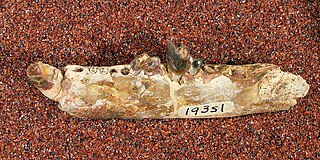
Uintacyon is an extinct paraphyletic genus of placental mammals from clade Carnivoraformes, that lived in North America from the early to middle Eocene.

Bryanictis is an extinct genus of placental mammals from extinct subfamily Didymictinae within extinct family Viverravidae, that lived in North America, from the early to late Paleocene.

The China Quarterly (CQ) is a British double-blind peer-reviewed academic journal established in 1960 on contemporary China including Taiwan.
Gobiops is an extinct genus of temnospondyl from the Jurassic of Mongolia, China, and possibly Kyrgyzstan. The genus is represented by a single species, Gobiops desertus. It was named in 1991 from the Late Jurassic Shar Teeg Beds of Mongolia. Additional material was described in 2005 from the Middle Jurassic Toutunhe Formation in the Junggar Basin of China. Gobiops belongs to the family Brachyopidae. The poorly known genus Ferganobatrachus, named in 1990 from Shar Teeg, is probably synonymous with Gobiops.
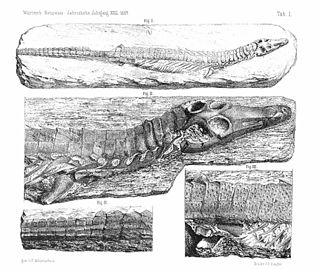
Dyoplax is an extinct genus of pseudosuchian archosaur, possibly an erpetosuchid. Fossils have been found from the type locality within the upper Schilfsandstein Formation in Stuttgart, Germany. The holotype specimen was a natural cast of a nearly complete skeleton that lacked only parts of the tail and limb bones.

Forum of Mathematics, Pi and Forum of Mathematics, Sigma are open-access peer-reviewed journals for mathematics published under a creative commons license by Cambridge University Press. The founding managing editor was Rob Kirby. He was succeeded by Robert Guralnick, who is currently the managing editor of both journals.
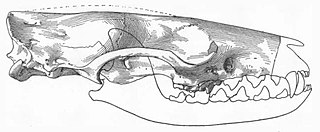
Viverravus is an extinct genus of placental mammals from extinct subfamily Viverravinae within extinct family Viverravidae, that lived in North America, Europe and Asia from the middle Paleocene to middle Eocene.
Palaeontologia Electronica is a triannual peer-reviewed open-access scientific journal published by Coquina Press covering paleontology. It was established in 1998 and is the oldest fully open-access electronic journal of paleontology. The journal is sponsored by the Society of Vertebrate Paleontology, the Paleontological Society, the Palaeontological Association, and the Western Interior Paleontological Society. The editors-in-chief are Julien Louys and Andrew Bush. In 2000, the first taxonomic names published electronically under new rules in the International Code of Zoological Nomenclature were published in the journal by Scott et al. (2000) for three new species of fossil foraminifera: Eggerella matsunoi, Haplophragmoides hatai, and Haplophragmoides nishikizawensis.
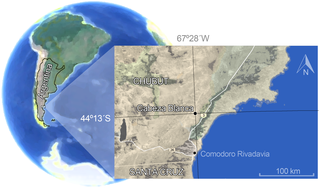
The Sarmiento Formation, in older literature described as the Casamayor Formation, is a geological formation in Chubut Province, Argentina, in central Patagonia, which spans around 30 million years from the mid-Eocene to the early Miocene. It predominantly consists of pyroclastic deposits, which were deposited in a semi-arid environment. It is divided up into a number of members. The diverse fauna of the Sarmiento Formation, including a variety of birds, crocodilians, turtles and snakes, also includes many mammals such as South American native ungulates as well as armadillos, and caviomorph rodents.















